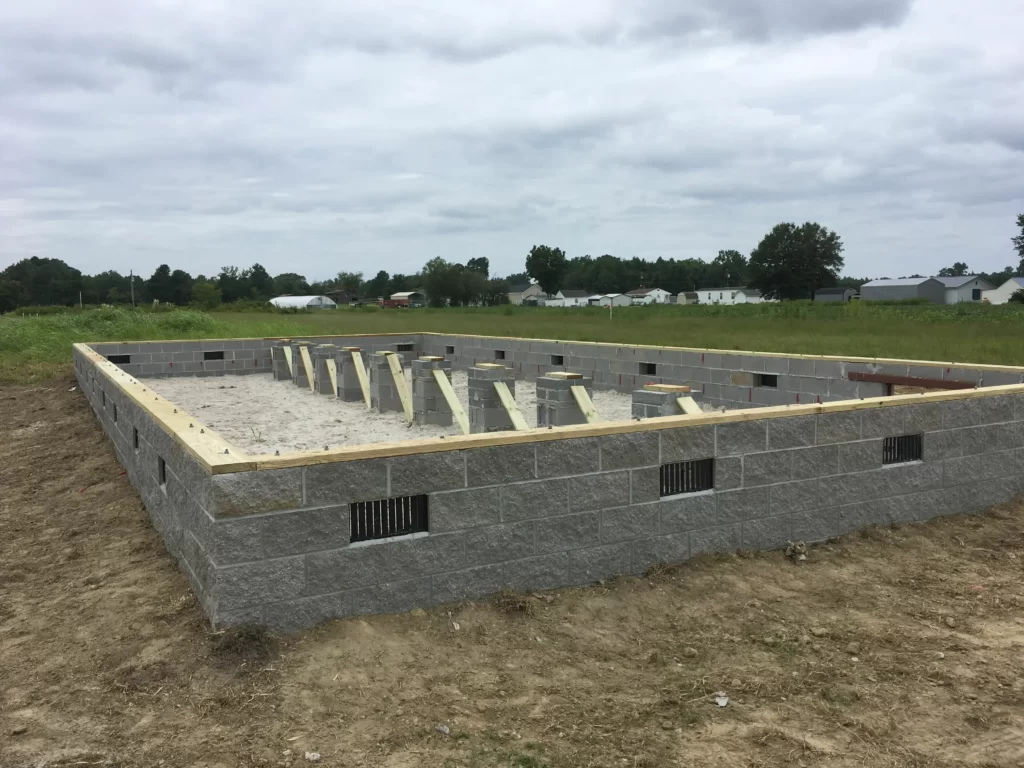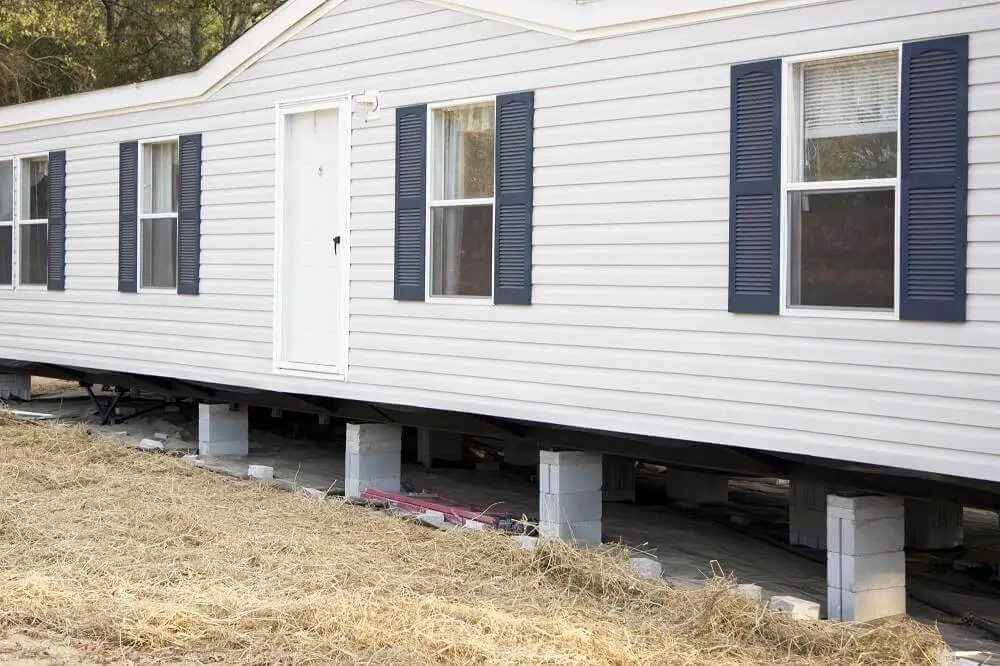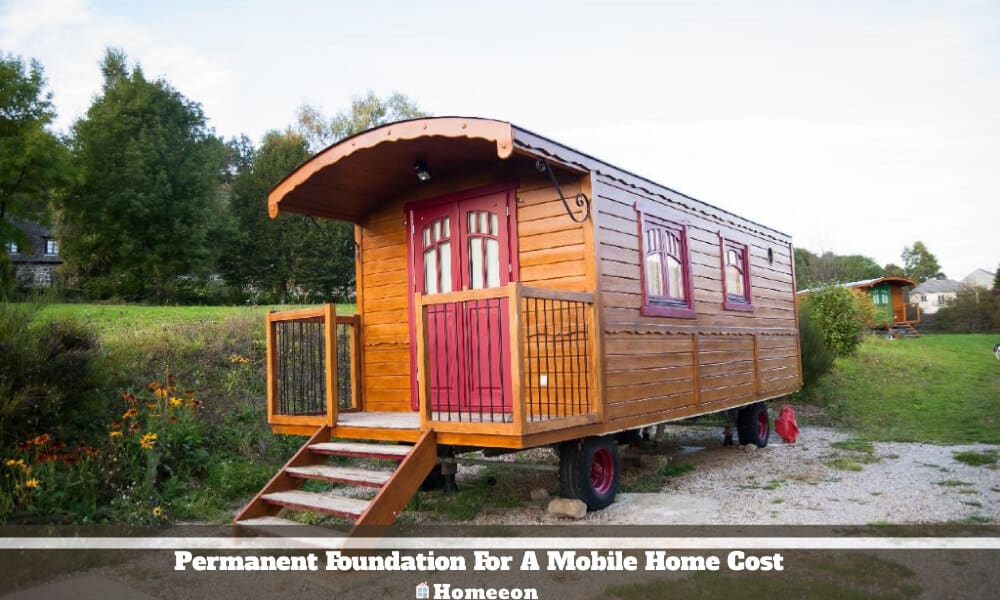Last Updated on August 2, 2023 By Emma W. Thomas
The cost of a permanent foundation for a mobile home varies widely depending on factors like location, size, materials, and labor costs. Generally, it can range from $10,000 to $25,000 or more. Consulting local contractors will provide a more accurate estimate.
What Is The Average Cost Of A Permanent Foundation For A Mobile Home?

Moving into a mobile home presents a myriad of benefits – affordability, flexibility, and more. However, establishing a solid and durable foundation is paramount to guarantee the longevity and stability of the home. The following list presents the average costs of a permanent foundation for a mobile home.
- Cost Overall:
The average cost to build a permanent foundation for a mobile home is approximately $5000 to $18000. This price range encompasses a variety of factors including the size of the home, location, materials used, and labor costs. - Size of The Home:
Larger mobile homes require a more extensive foundation, thereby raising the cost. For instance, the foundation for a double-wide mobile home could cost around $10000 to $13000, whereas a single-wide home might cost around $4500 to $6500. - Materials and Labor:
The choice between a concrete slab or pier and beam foundation can alter the cost considerably. While pier and beam foundations might range from $5000 to $8000, concrete slabs could range from $7000 to $12000. Labor costs further add to this, generally ranging from $500 to $1500.
| Foundation Type | Cost Range |
|---|---|
| Pier and beam | $5000-$8000 |
| Concrete slab | $7000-$12000 |
- Location:
The geographical location of the home significantly impacts cost. Factors such as the state, local building codes, ground conditions, and transportation costs of materials can create variability in the overall cost. - Additional Expenses:
Additional expenses such as plumbing, insulation, vapor barriers, and soil testing should be accounted for. These costs could add an extra $1000 to $3000 to the total sum. - Professional Inspections:
Many locales require a professional inspection of the foundation, adding an average of $300 to $500 to the overall cost. - Permitting:
Leaders should also consider the cost of necessary building permits, typically varying by local jurisdiction and adding another $300-$400 on average.
To summarize, the cost of a permanent foundation for a mobile home depends on a multitude of factors. By estimating each line item, homeowners can budget for an appropriate and stable foundation that guarantees the durability and longevity of their mobile home.
Types of Permanent Foundations For A Mobile Home and Their Costs
| Type of Permanent Foundation | Cost (US Dollars) |
|---|---|
| Piers and Ground Anchors Foundation | These are the simplest forms of a permanent foundation and are most common in mobile homes. They can range between $1,000 to $3,000 depending on the size of the mobile home and the local labor costs. |
| Slab Foundation | This is a flat concrete pad poured directly on the ground. It’s a very stable option for a mobile home, but more expensive than piers and ground anchors. The cost can vary between $4,500 to $12,000. |
| Block and Beam Foundation | This is the traditional type of foundation that provides excellent stability. However, it requires a significant amount of excavation and construction. It’s among the more expensive options, costing between $5,000 to $15,000. |
| Crawl Space Foundation | It raises the mobile home off the ground, providing easy access to utilities and improving flood resistance. The cost is similar to the block and beam foundation, ranging from $5,000 to $15,000. |
| Basement Foundation | This is the most expensive type of permanent foundation as it requires the most excavation and construction. However, it adds significant living and storage space. Its cost can range from $20,000 to $60,000. |
What Are The Types Of Permanent Foundations For A Mobile Home?
Permanent foundations are fixed immediately after being built and they provide stick-built support for the mobile home. There are two types of permanent foundations, namely; – basement foundations and pit foundations.
Basement Foundations
Basement foundations provide both structural support and additional living space to the mobile home. The advantage of this type of permanent foundation is that it can easily integrate into one’s housing plans, especially with the added extra living space created. It can also help real estate with financing options. Basement foundations are also known to have good earthquake resistance.
There are some disadvantages associated with the permanent basement foundation, such as the tendency to get flooded in cases of heavy downpours. They are also difficult to construct to meet the building codes which is a must. Basement foundations are the most expensive foundations with a very long and complex installation process.
Pit Permanent Foundations
They are not so different from the basement foundation. The only significant difference is that with a pit foundation, a pit is dug out of the soil, forming a crawl space that is not livable. Their advantage is that they also give a permanent stick and firm grip to the home. They also allow storage of extra facilities in the dug pit, which creates extra space even though it is not livable. Pit foundations also tend to be cheaper hence offering better financing options.
Pit foundations are at a greater risk of flooding. Their construction process is also long and challenging, making them costly as well.
What Are The Other Types Of Mobile Home Foundations?
Other than the two types of permanent foundations, there are types used for both mobile and manufactured homes. They include;
Pier And Beam Foundation
It is the most commonly used foundation for mobile homes. It involves driving anchors on the ground to hold the mobile home down, protecting it from strong wind forces. The anchors are first driven to the ground, and steel straps get attached to them. The straps act as a connection to the main beam on the steel frame of one’s home. Outriggers are then welded to the steel beams for extra support and strength.
The advantage of pier and beam foundations is that they are very cheap and easily affordable. They take less time to install than permanent foundations. Additionally, they can be used in extreme weather conditions such as floods, heavily frosted and seismic areas. Their ability to withstand such harsh conditions and act as wind zone resistors makes them preferable over other foundation types.
Crawl Spaces Foundation
Crawl space foundations designed for mobile homes are made of excavated floors. They are built with poured concrete footers that run down to the ground for anchorage. The mobile home’s frame rests on a wall supported by piers strategically placed to offer support. These points are customized differently in each home.
Crawl space foundation installation price ranges between the permanent foundation and the pier and beam foundation, meaning it is relatively fair. The time taken to install them is almost the same as the pier and beam. They also have high wind resistance ability, seismic resistance from their strong stability, and can withstand frosty situations. Their only disadvantage is they are prone to floods and hence cannot be used in areas that experience heavy downpours.
Slab Foundations
A slab in mobile houses acts as more of a support system than a floor to the home. In this case, a slab rests on top of the ground with anchors held on concrete. It is insulated around its perimeter, keeping the ground warmer which generates warmth to the mobile home.
Slab foundations are among the cheapest and most affordable mobile home foundations. They require very little time for their installation and are seismic-compatible. They can be used in flood-hazard areas and frosty environments since they are insulated and are not easily affected. However, they are not suitable for sloping areas, and one has to verify wind zone requirements for the site before installation. They are not commonly used like the crawl space and pier and beam foundations.
What Things Should One Consider When Preparing Land For A Mobile Home?
The best advantage of a mobile home is that they allow one to establish it on vacant land more quickly than the other conventional site-built constructions. However, they have a similarity in that land preparation before installation and setup is very crucial. The following are some essential tips to consider to ensure a perfect installation of the mobile home.
Requesting For A Land Survey
It is an important step for any site work preparation, which involves site inspection. You must have updated information instead of relying on an old survey with vague descriptions and incorrect information with outdated landmarks. A current site inspection will provide clear information on any discrepancies between both survey inspections. It will also indicate whether one’s land status is suitable for a mobile home or not.
Application For Necessary Permits
Some permits are required when installing a mobile home. They include transport permits, building permits, occupancy permits, and in other cases, a utility connection permit. One can visit government sites to learn more about mobile housing and get more details on permits needed to transport and install the home. For instance, some states require one to submit permit applications at least six weeks before the scheduled transportation and installation of the mobile home.
Selecting The Location Of One’s Home
Before the installation, one should have clear markings of boundary lines of one’s property to establish a specific location of the mobile home. It helps one make decisions such as available room for the driveway and the available outdoor space after installation. Planning the site’s access before installation and setup is very important. One can even consider removing any unwanted vegetation such as shrubs and trees.
Installing The Foundation In Advance
If one is considering a permanent foundation, it should be done early in advance as it involves pouring thick concrete that requires time to cure and dry fully. How first the concrete will cure and dry depends on the prevailing weather conditions of a place. To avoid inconveniences and delays in installation, one should consult with the builder to ensure the foundation is perfectly ready before the mobile home is installed.
Setting Up The Needed Utilities
Bringing in utilities is another important activity to be carried out before the actual mobile home installation. The best thing is to communicate with mobile home contractors and dealers to ensure all utility services are readily available by completing the installation.
What Should One Consider Before Putting Their Mobile Home On A Permanent Foundation?

One should take their time to ensure the mobile home and the foundation fit their lifestyle and are perfect. The first thing to consider is the surrounding area and social amenities available as they all influence the value of the mobile home. Another consideration is the building permit and other licenses applicable. Application of such permits takes time before they are processed and obtained but are a must in the construction of permanent foundations. Materials used in the construction of a permanent foundation are the most costly. For this reason, one should consider hiring credible and reliable workers to ensure that the materials are sparingly used without waste.
Conclusion
Mobile home permanent foundations are quite expensive compared to semi-permanent foundations. The reason is mostly because of the materials used and the labor required making them costlier.
Other foundations such as slab foundations and pier beams are relatively cheap and are mostly considered to withstand harsh weather conditions. Permanent foundations are also prone to floods and hence are not preferably used in areas that are likely to experience heavy downpours.
References:
https://www.howmuchisit.org/perm-foundation-mobile-cost/
https://upgradedhome.com/permanent-foundation-for-a-mobile-home-cost/
Emma is a graduate of Domestic Science or Family and Consumer Sciences (Home Economics) from the University of Wisconsin. She has 7 years of experience Working with the strategic section of BestBuy and now writing full-time for Homeeon.
From Managing the Home, Interiors, Cleaning, and Exteriors to Gardening and everything about Making A Home Liveable – is her passion and this Homeeon is the result of this.
Emma loves decorating her home with the best stuff found online. She cares about quality over anything and writes reviews about them here in Homeeon. Get in touch with her over Pinterest.
Keep reading her blogs.

